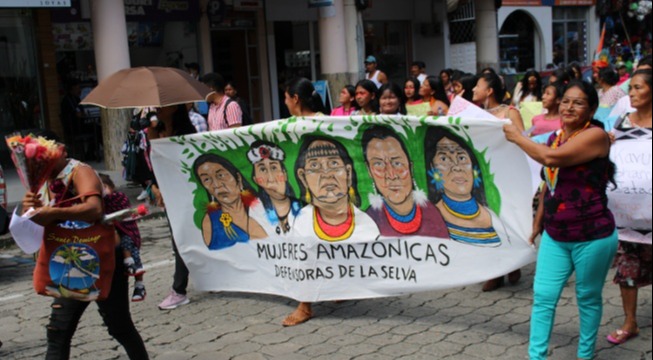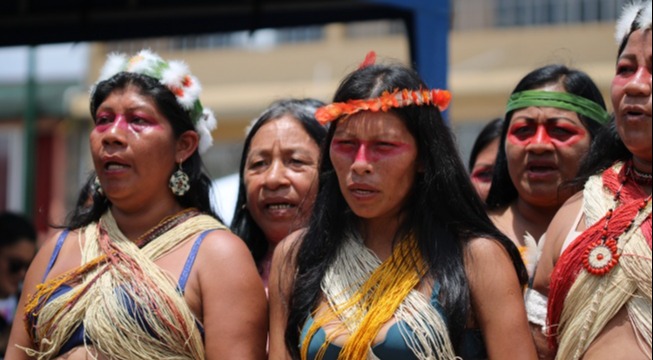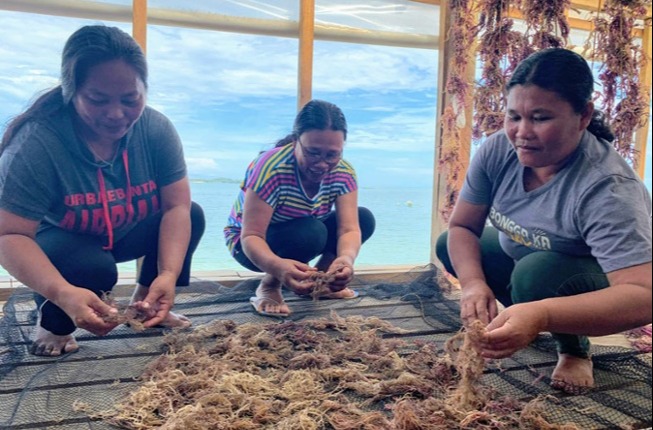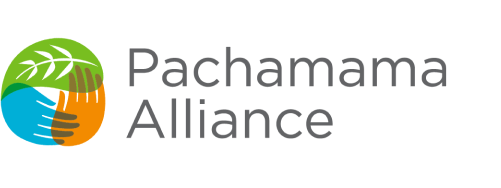 Las Mujeres Amazónicas—a collective of Indigenous women protecting the Amazon rainforest against extractivism—marching in Puyo, Ecuador in 2023.
Las Mujeres Amazónicas—a collective of Indigenous women protecting the Amazon rainforest against extractivism—marching in Puyo, Ecuador in 2023.
Though the climate crisis is a global phenomenon impacting people everywhere, not everyone is impacted in the same way nor does everyone have access to the same resources for addressing it.
The climate crisis exacerbates existing social inequalities, including those based on gender as women experience cultural, political, and economic barriers. At the same time, gender inequality further worsens and compounds climate change impacts, while restricting women’s access to resources and support for managing these changes.
Despite this, women have been at the forefront of implementing solutions to the climate crisis. However, leading climate action shouldn't cost women their safety, health, and wellbeing. Nor should they continue to sacrifice these things while shouldering a disproportionate burden of climate change impacts and the responsibility for addressing them.
To better understand the connection between gender and the climate crisis, including how gender equality is a key piece of ending the climate crisis, an ecofeminist perspective is essential.
What is Ecofeminism?
Ecofeminism, or ecological feminism, is a movement and framework that highlights the relationship between women and nature, including the inextricable link between the oppression of women and the climate crisis. It uncovers the ways in which women play a crucial role in caring for nature and our communities through their labor and knowledge while being barred equitable access to social, political, and economic rights and benefits.
By illuminating the ways in which gender-based oppression and the climate crisis are interconnected, ecofeminism strikes at the root causes of both: the extraction, exploitation, and devaluing of nature and those considered “other.” As climate justice and queer feminist activist Majandra Rodriguez Acha puts it, they are “those whose bodies, lives and dignity are taken as a means to the end of accumulation: Indigenous groups who have been colonized, workers on the lower rungs, black and brown ‘minorities’ and women who are at the crossroads of multiple kinds of oppression.”
Centering the voices and experiences of women—particularly those who are BIPOC and/or low-income—is crucial for not only understanding the wide range of climate change impacts, but also for identifying the most effective climate justice solutions. However, understanding the impact of the climate crisis on women and supporting their leadership are not enough to resolve the climate crisis. Change on a systemic level is necessary.
Ending the climate crisis requires transforming systems that extract from and exploit the Earth and certain groups of people such as women. This starts with ensuring women have fair access to resources, decision-making power, rights, and opportunities while equitably distributing the responsibility of caring for our communities and the ecosystems we’re a part of.
How Gender Inequality Exacerbates Climate Change Impacts
Gender inequality exacerbate the impacts of the climate crisis. These impacts are further compounded when gender intersects with other aspects of identity like race and socioeconomic class.
In particular, Indigenous women and women in poor, rural communities are on the frontlines, experiencing the first and worst impacts of climate change. Climate change affects women in rural communities uniquely because they have a direct relationship to natural resources and local ecosystems. Many of these women travel daily to procure water and firewood, forage for or grow food, and care for livestock as caretakers of their families and communities. When climate change impacts—such as drought—worsen, women must work harder and longer, travel further, and navigate more obstacles in order to provide for their families.
Gender and Climate Catastrophes
Natural disasters disproportionately impact women, with BIPOC women and poor women being hit the hardest.
In Sri Lanka, it’s easier for men to survive tsunamis because swimming is mainly taught to boys and not girls. During the 1991 cyclone catastrophe in Bangladesh, 90% of the 140,000 people who died were women. During Hurricane Katrina in the United States, a majority of people trapped in New Orleans when the hurricane hit were Black women and their children—the poorest demographic group in New Orleans.
Overall, 80% of people displaced globally by climate change are women. This is mainly because of women’s disproportionate lack of land ownership, higher rates of poverty relative to men, and a lack of access to resources and support that could help them prepare for or recover after natural disasters.
Climate Change and Gender-Based Violence
As climate crisis impacts worsen, incidences of gender-based violence towards women and girls increase—particularly so for Indigenous women and girls.
Nearly two-thirds of the women Earth defenders—those who work to protect nature and their communities from extractivism—who were killed in 2021 were Indigenous women. In Canada, Indigenous women and girls are 12 times more likely to go missing or be killed. In the United States, the rate of murder for Native women is 10 times more than the national average.
Much of the violence against Indigenous women and girls are linked to “man camps,” temporary housing for workers—who are predominantly men—of resource extraction projects such as mining and oil extraction. Taking this into consideration, the link between extractive industries and violence against Indigenous women and girls—which is rooted in historical legacies of racism, colonization, and patriarchy—is stark.
Barriers to Gender Equality
Barriers to gender inequality persist as a result of a complex web of patriarchal norms, discriminatory practices and policies, unequal access to resources—such as food, water, land, and capital—and a lack of acceptance of women’s leadership and perspectives in decision-making spaces.
Consider the following:
- Globally, women aged 25-34 are 25% more likely than men to live in extreme poverty.
- Women make up 43% of the global agricultural labor force, and women and girls account for 60-80% of global food production. And yet, women only make up 15% of agricultural landholders
- Despite the fact women make up half of the world population and are disproportionately impacted by climate change, the average representation of women within national and global climate negotiating bodies is below 30%.
- Globally, women and girls account for 75% of unpaid care work. If women and girls earned minimum wage for the unpaid care work they do, they would earn a total of $10.8 trillion annually.
Though women’s knowledge and labor play a crucial role in sustaining our communities, women are often invisibilized, undervalued, unheard, and underserved.
The Role of Women’s Leadership in Addressing the Climate Crisis
Despite the social, political, and economic barriers they face, women have been advocating for change from the frontlines, with BIPOC and low-income women often leading the way.
In communities around the world, women have been developing adaptation and mitigation measures and implementing solutions to address the climate crisis.
Women at the Forefront in the Amazon Rainforest
 Women from the Waorani Nation participating in the march led by Las Mujeres Amazónicas in Puyo, Ecuador. Image courtesy of Fundación Pachamama.
Women from the Waorani Nation participating in the march led by Las Mujeres Amazónicas in Puyo, Ecuador. Image courtesy of Fundación Pachamama.
Las Mujeres Amazónicas is a collective of Indigenous women from the Amazon rainforest who center the voices and needs of their communities who are facing the consequences of extraction in their territories.
The movement led by Las Mujeres Amazónicas began in 2013 as a response to the Ecuadorian government selling oil concessions in their territories. Since then, they have organized protests and demonstrations, including in 2018 when they organized 500 Indigenous women in Quito, Ecuador. Their mandate to the Ecuadorian president included 22 demands addressing land rights, gender-based violence, and climate change. As a result, the Indigenous women were threatened and attacked for speaking out.
To this day, the women of Las Mujeres Amazónicas face threats for their ongoing efforts to bring justice for their people and territories. Despite this, they continue to advocate for the protection of their land, communities, and rights while bringing attention to gender-based violence and the disproportionate impact of climate change on Indigenous women.
Women’s Leadership in Coastal Communities in the Philippines
 Seaweed farmers in Palawan, a province in the Philippines. Image courtesy of Imelda Abaño and Mongabay.
Seaweed farmers in Palawan, a province in the Philippines. Image courtesy of Imelda Abaño and Mongabay.
Women from coastal communities in the Philippines are leading local climate action in the face of a rapidly changing environment.
Fishing has sustained communities on the island of Palawan for many years. But with the acceleration of climate change, it’s become increasingly difficult for fishermen in Palawan to continue sustaining themselves and their families.
To supplement their household incomes, many of the women in these communities have started farming seaweed. Now, more than half of the seaweed farmers in Palawan are women. Their seaweed farms have become grazing spots for many different marine species, supporting local biodiversity while providing a source of income. To strengthen their resilience in the face of climate change, the women have identified adaptive strategies, including implementing an early warning system for typhoons, using different harvesting and drying techniques, and finding more effective equipment.
Women-led Regenerative Agriculture and Food Justice Initiatives in the U.S
 Participants of Soul Fire Farm's training. Image courtesy of Soul Fire Farm.
Participants of Soul Fire Farm's training. Image courtesy of Soul Fire Farm.
Leah Penniman is one of the key figures leading the movement to support Black, Brown, and Indigenous farmers through regenerative agriculture and food justice initiatives at Soul Fire Farm, where Leah is a founding co-director and farm manager.
Leah and her team offer trainings on regenerative farming, and have created a subsidized farm food program for communities impacted by food apartheid. Their initiatives show how Black and Indigenous ancestral methods of farming capture carbon in the soil and mitigate climate change while producing food and medicine. Soul Fire Farm’s regenerative agriculture practices not only benefit farmers, but also the ecosystem as a whole by strengthening biodiversity and soil health.
At the center of Soul Fire Farm’s work is a focus on food sovereignty, racial justice, and reverence for the land. This includes the honoring of and making visible the contributions of Black, Brown, and Indigenous farmers to agriculture in the U.S. and the global food system while bringing to light the disproportionate impact of climate change on BIPOC communities.
Soul Fire Farm has played a significant role in the creation of other BIPOC-led farms across the United States that similarly practice regenerative agriculture while bringing greater food justice to communities of color.
Women Developing New Climate Knowledge and Solutions in the Andes
Tarcila Rivera Zea is a renowned Indigenous activist in Peru whose work has been instrumental in illuminating the struggles and experiences of Indigenous peoples, including Indigenous women who are at the forefront of climate change
According to Tarcila, women in the Andes are developing new knowledge through close observation of their local environment. One way they’ve done this is through observing the behavioral changes of animals and insects where they grow their crops. Specifically, as these women have been tending to their crops, they’ve started finding a particular species of worm at higher altitudes than they normally would. The women have come to learn that the rising temperatures at lower altitudes are suffocating the worms and driving them to higher altitudes.
The women have also learned how to manage these changes and the threat that the worms pose to their crops. They’ve discovered that there are certain crops that repel the worms and have started planting those more, while sharing this knowledge with others in their communities. These women, through their labor and their connection to their local ecosystem, are producing new bodies of knowledge and understanding around climate change impacts and effective adaptation measures.
Women’s Leadership is Essential for Change
When women lead climate action and participate in environmental decision-making at all levels, communities and ecosystems are more likely to see positive change.
Research shows that a higher presence of women in decision-making bodies translates into more ambitious climate goals and policies. Women are also more likely to support policies that require greater transparency into the production of goods, transport goods using clean energy, and stop the use of fossil fuels.
Given the important role of women’s leadership in addressing the climate crisis, it’s critical to advance gender equality so that women no longer have to overcome undue barriers to taking and leading action. At the same time, understanding the ways in which the oppression of women and the destruction of nature stem from the same root causes is key to ensuring a thriving future for all.


